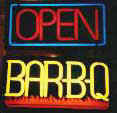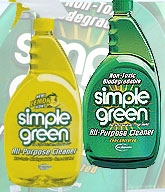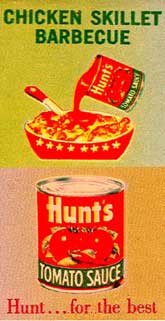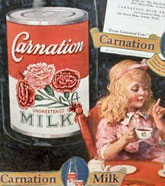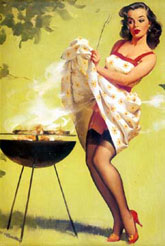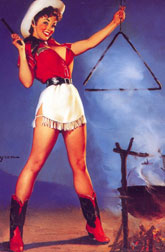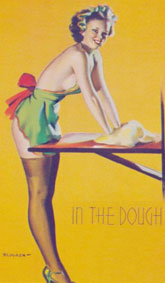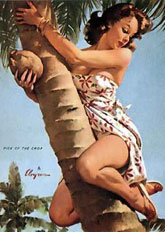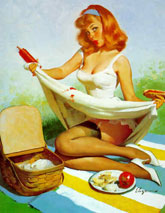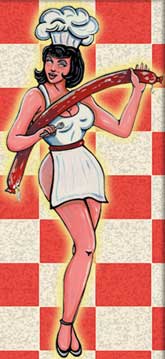Contact BBQbyDan
www.BBQDan.com
Search
KCBS BBQ Cook-Off Info
Recipes,
Smoking Meats
Recipes, Grilling
|
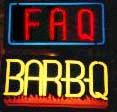 |
FAQ OF THE INTERNET BBQ LIST Version 2.0 Section 24 Barbecue Book Reviews |
24. Barbecue book reviews
--------------------[Has anybody reviewed any of the recent books on barbecue?]
"Texas BBQ"By: Paris Parmenter & John Bigley
Published by: Pig Out Publications, 1994
ISBN: 0-925175-20-X
List Price: $14.95
Review by: Garry Howard
When I first saw it show up on a bookseller's list on the Internet, I jumped at it. I have been looking for a good book that covers the topic of Texas barbecue in depth. Unfortunately, "Texas BBQ" isn't it. Half the book consists of brief descriptions of Texas barbecue restaurants. I say descriptions rather than reviews because they don't really critique them, just provide a description of the place. I suspect they may have even charged the restaurants a fee to be included. While it lists all the classic places, it also includes Tony Roma's - A Place For Ribs and Dick's Last Resort (hardly barbecue). Reviews from the Austin Statesman available on the Internet are a much better guide to the best in Texas barbecue joints.
The rest of the book consists of recipes but they are less than notable. One barbecue sauce recipe consists of Heinz Chili Sauce, maple-flavored pancake syrup, and apple jelly. Yuck! Most are from restaurants, or other establishments like the Lake Austin Spa Resort (only 28 calories per tablespoon), The National Turkey Federation, The Texas Beef Industry Council, Pace Foods, National Pork Producers Council, etc. It makes me suspect they pulled most of these recipes out of these organization's pamphlets. In the back of the book is a listing of competition and cookoff schedules. Since these schedules tend to change frequently, it couldn't possibly be accurate.
If you are looking for an index of restaurants in Texas that can loosely be called barbecue or recipes for faux Q then this book is for you. If you are wanting to learn something about Texas barbecue you'll be disappointed just like I was.
============== "John Willingham's Championship BBQ"By: John Willingham
Published By: William Morrow & Company, 1996
ISBN: 0-688-13287-1
List Price: $25.00
Review by: Garry Howard
A barbecue cookbook with a title like "John Willingham's Championship BBQ" sets high expectations. After all, John Willingham has won more national barbecue championships that just about anyone. He obviously knows his stuff when it comes to cooking barbecue at a championship level. However, this book doesn't live up to the expectations it sets. The bulk of the book is a lot of non-barbecue filler and only a small portion of the content was contributed by John Willingham.
The book starts out with a brief 6 page biography that gives you a little insight into John Willingham the man and how he got started in barbecue and competition cooking. Chapter 2 entitled "How to Cook Barbecue" is exactly 8 pages of double spaced print. Then it launches into the recipes.
Chapter 3 is called "Starters" and includes such barbecue classics as Deviled Eggs, Bar-B-Q'd Pork Pizza with 10 of the 16 recipes credited to someone else. The next chapter is "Biscuits, Rolls, and Breads" 6 out of 8 credited to someone else. Still waiting to get to the barbecue.
Finally, the chapter "Slow-Cooked Heaven: Real Barbecue" with Willingham contributing 6 of the 11 this time. This chapter (22 pages) is the real meat of the book and has some good information on how to cook pork shoulder, ribs, brisket, and chicken.
Next is a chapter on "Grilling". OK, grilling is related but it isn't really barbecue. Besides there are a lot of better grilling books on the market including Chris Schlesinger's. This section, however, has 23 recipes, 6 of them Willingham's.
The following chapters are similar filler. "Down-Home Chicken, Fish, and Seafood" No barbecue here but if you like somebody else's recipe for Chicken and Vegetable Noodle Casserole you're in luck. Nine recipes here, 3 by Willingham, including his fried chicken and fried fish.
Next is "Beans and Chilis", "Fixin's: Vegetable Side Dishes", and "Slaws, Salads, Dressings, and Sandwiches". Side dishes and slaws are essential accompaniments to barbecue but I never had Mashed Potatoes, Creamed Fennel and Corn or Mashed Yucca with mine. In these 3 chapters are 36 recipes, with only 6 by Willingham including his world famous Baloney Sandwich recipe. Not only is a baloney sandwich recipe a little strange to find in a cookbook entitled "John Willingham's World Champion BBQ" but it has mayo, tomato, onion, cheddar cheese, 2 slices of baloney and the secret baloney sandwich ingredient PEANUT BUTTER. YUMMY!
Finally we get to the other barbecue related chapter "Barbecue Sauces, Dry Rubs, Seasoning Mixes, Marinades, Glazes and Savory Sauces". Here's where we finally get to learn some more of "John Willingham's World Champion BBQ" secrets. It contains 12 barbecue sauce recipes, 9 rub and seasoning mix recipes, 5 marinades, and 8 miscellaneous sauce recipes including Tartar Sauce. I use a lot of that on my barbecue! Of the 34 recipes, 16 are by Willingham. Not a bad ratio, but I didn't really need Willingham's Tartar Sauce recipe, or for that matter Chowchow, or Horseradish Cocktail Sauce ("What's this good for?" It says. "How about cold shrimp or crabmeat? Yum!" but unfortunately there aren't any recipes for barbecue crabmeat.) There are also a series of "glaze" recipes for ham and lamb. They hardly qualify as recipes though. One glaze is a mixture of ketchup and Worcestershire sauce and another merely calls for laying slices of canned pineapple on the lamb while it is roasting. Not much creativity here.
The final chapter is logically "Desserts". I'm usually too full for dessert after some good barbecue but some people like it I guess. Again, it doesn't have much to do with "John Willingham's World Champion BBQ". There are 19 recipes, 3 by Willingham.
To give credit to Willingham, his brief 8 page overview on How to Cook BBQ might be interesting if you never heard of barbecue before and don't have a clue about what a smoker is and have never cooked any barbecue in your life. It would be nice to have some information about the various smoker designs and their pros and cons. Or some advice on which woods to use with different meats and why. Instead we get such words of wisdom as "Hickory became the wood used by most Southern 'cuers because it grew in the region." Duhh! So do pine trees. He goes on to explain "There are more than fifteen varieties of hickory wood in the South - if you don't know the difference, you can ruin a cookin'." This is the first I have ever heard that using the WRONG kind of hickory can ruin your barbecue. This is NEWS! It would be nice if he bothered to explain to us the reader what the different varieties are, how to tell them apart, and exactly what is going to happen if I pick the wrong one. He throws in "Out west, I hear, they use alder wood for smoking salmon - but it's a stretch to call that barbecue!" This from a man who has a recipe for baloney sandwiches with peanut butter on them in his book entitled "John Willingham's World Champion BBQ". I would much rather have seen a smoked salmon recipe.
His barbecue sauce and Rub recipes are also worthwhile examining but again no earth shattering championship secrets here. The material in this book could have been packaged together into a 15 page booklet entitled "BBQ for the Beginner" instead of a $25 cookbook that promises on the booksleeve "Here are clear instructions for determining what type of cooker to use; laying a perfect fire to minimize smoke and maximize taste; getting a rich marbled taste out of any cut of meat." It goes on to say "John Willingham explains what real Bar-B-Q is -- and isn't -- and provides the techniques and tips that have won him accolades but are so simple even a backyard 'cuer can use them." If any of that stuff is in this book I sure couldn't find it. Save $25 and read the BBQ List FAQ instead. Willingham's book is one of the least useful barbecue books I own.
============== "Paul Kirk's Championship Barbecue Sauces"By: Paul Kirk
Published By: Harvard Common Press, 1998
ISBN: 1-55832-125-X
List Price: $11.95
Review by: Garry Howard
This new book by barbecue cookoff champion Paul Kirk isn't a generalized barbecue book. It is about Barbecue Sauces. However, in the 9 page introduction Paul Kirk manages to communicate more barbecue knowledge than many entire barbecue books. He covers explaining the difference between a water smoker, an offset smoker and a kettle grill. In Fuels he explains the different woods, the characteristics they give and which he prefers and why. He also talks about green vs. aged wood, using chips and charcoal and briefly talks about starting and tending a fire. Finally, this "Introduction" covers the basic techniques for Pork Ribs, Pork Shoulder, and brisket in both a smoker and covered grill method. This brief introduction is no exhaustive text on the art of barbecue but it covers the basics very well and is 100% useful content.
Chapter 1 is entitled "Basic Ingredients - An Exploration of Spices, Seasonings, Mustards, Oils and Vinegars." Instead of launching right into a bunch of other people's recipes, this chapter covers in-depth the spices and seasonings used in barbecue rubs. Kirk starts out by building a foundation of background information so you can understand why you would want to use one spice or another. Then he develops what he calls a barbeque "flavorprint", or a list of spices that distinguishes a national cuisine, such as French, Mexican, or Italian. If you taste a dish that has curry powder in it you know you are tasting the flavorprint, or unique cooking, of India. Instead of just another rub recipe, he has built a list of basic spices that characterize barbecue to select from in building your own unique recipes (The barbecue flavorprint). Then he provides a "Master Barbecue Spice" recipe to use as a starting point that you can add to and subtract from to make your own.
He discusses the use of salt and explains the difference between Table salt, Iodized salt, Kosher salt, Sea salt, and Rock salt. Hey! What a concept. A barbecue cookbook that you can actually learn something from. This chapter continues on to discuss chiles and chili powder, mustards, oils, and vinegars including some sample base recipes for how they might be used. The emphasis, however, is on building background knowledge that will be used later in the book.
Chapter 2 is Barbecue Seasonings and Rubs. This chapter, as are others to follow is in the form of a "Master Class" and is based on Paul Kirk's BBQ classes. Paul says "Instead of giving you my rub recipe, I think you will benefit more if I teach you how to develop your own rub, so that's what the Master Class is all about: how to create your own championship rub." He also goes on to say "And for those of you who are too lazy to construct your own rub, or who are simply interested in trying out some tried-and-true rubs, there are eighteen more recipes, including some that have no salt and some that have no sugar." He shares facts like "last year more than 75 different teams on the barbecue circuit used a wet rub."
The first step in his Master Class is to Observe The Competition and The Masters. He has a table comparing the ingredients from his own K.C. BBQ Seasoning & Rub, Cain's Barbecue Spice, K.C. Rib Doctor BBQ Rub, Soul Chef-Chicago Spicy BBQ Seasoning, Basic Texas Rub, and Johnny's Pork & Chicken Seasoning. The ingredients don't have quantities but are listed in decreasing amounts so you can see the predominant seasoning used in each one. The next step is to compare all the ingredients of each rub and finally construct "your" championship rub. He leads you through step by step how to select and blend the ingredients. He then covers "signature" spices you can add in small amounts to enhance "your" rub. He then has an example rub recipe constructed according to the techniques described in the Master Class followed by the recipes for those too lazy to develop their own. All together, 24 pages devoted to how to develop your own unique barbecue rub.
A similar format of Master Class, example recipe and other recipes is followed through the rest of the book covering Marinades, Mops, Sops, and Bastes, Barbecue Sauces, and Salsas, Relishes and Ketchups. Not a Mashed Potato, Baloney Sandwich or Dessert recipe in the bunch. 100% barbecue knowledge and content.
Since the title of the book is barbecue sauces, I'll review a little of the barbecue Sauce chapter. It starts with step one, Analyze the Ingredients listing ingredients that are tomato based, sweet, sour, other liquids, and spices and seasonings. Then there is a worksheet you can use to write down your use of each category of ingredients, the amount and notes. This is used for Step Two: Define the Ingredients List For Your Sauce and then finally Make The Sauce. Followed by lots of recipes covering regional barbecue styles including Kansas City, Memphis, Texas, Cajun, Carolina Mustard sauce (including a recipe that won 2nd place in the 1994 American Royal International Barbecue Sauce Contest), Piedmont regions of Carolinas and Georgia, Lexington NC Style, Eastern NC Style, Oklahoma, and even the infamous White barbecue Sauce.
In the back of the book is Resources with addresses and phone numbers of sources for Spices and Seasonings, BBQ Sauces and Bottling, Whole Hogs, BBQ Pits, Smokers and Grills, BBQ Societies and Publications, Commercial Product Development, and BBQ Classes and Videos.
In summary, if you want to learn something about barbecue, especially the spices, seasonings, and ingredients used to prepare rubs and sauces and how to develop your own personal recipes, get this book. This is one of the best barbecue books I own and I have close to 30. And the best part is the list price of $11.95. I bought it in a local bookstore for $10.76 and it's worth every penny.
============== "Jack Daniel's Old Time Barbecue Cookbook"By: Vince Staten
Published By: The Sulgrave Press 1991 (sixth printing 1996)
ISBN 0-9624086-2-X
List Price: $24.95
Review by: Garry Howard
This book was a real surprise. When I ordered it, sight unseen, I just expected some kind of promotional stuff from Jack Daniel's but instead it is actually a great barbecue book. It is written by Vince Staten, author of the classic "Real Barbecue". It starts with the sentence "Barbecue is 99 percent inspiration and 1% sauce". It discusses equipment, tending a fire, wood, meat, how to tell when it's done. It then launches into ribs, pork shoulder, whole hog, brisket, and chicken. The next chapter is The Search For The One True Sauce and has Eastern NC, Lexington style, South Carolina, Alabama and Georgia, Texas, Kansas City, Owensboro KY, and Tennessee sauces. Like most barbecue cookbooks, however, this one diverges into dishes to accompany barbecue including side dishes, breads and desserts. These recipes are authentic southern cooking, however. It also has a chapter on grilling. It includes a chapter called The Great Tennessee Barbecue Safari that takes you on a tour of Tennessee barbecue joints. The book is printed on glossy paper and is filled with beautiful color photographs. The $24.95 list price seems high for such a slim volume (190 pages), but it can be purchased at discount. I highly recommend this book.
Go to the next section
Return to the Table of Contents
Return to the BBQ FAQ Home Page
Comments or Suggestions
BBQ FAQ Ver 1.0, 2.0 ©1997, 1998 William W. Wight. All rights reserved.

